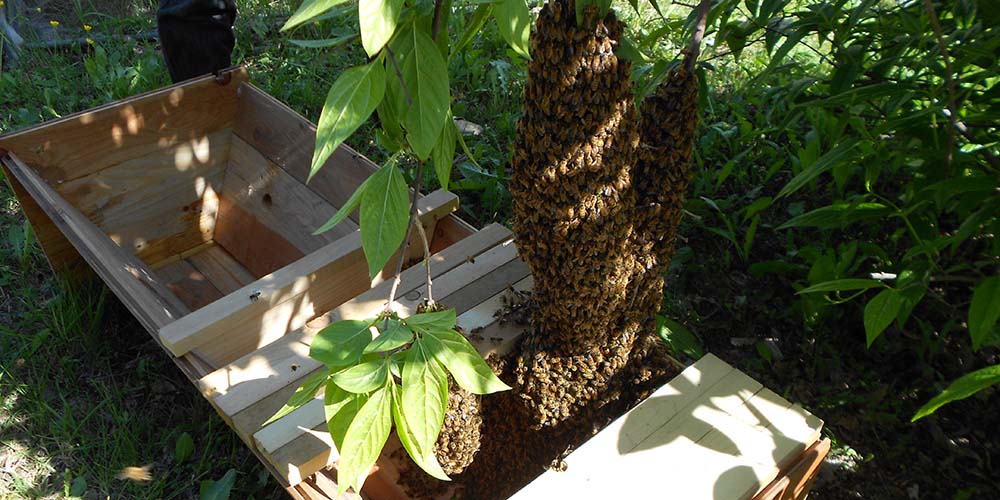Bee health and biodiversity may not be the most obvious connection. The first thing that comes to your mind could be flower diversity – it’s important for bee nutrition and, therefore, health. But this time, it’s all about the value of biodiversity for avoiding virus infections. Something mostly unexplored. To be honest, a connection I discovered only with a very interesting paper by Michelle Fearon and Elizabeth Tibbets. They found that diverse pollinator communities “dilute” the prevalence of virus infections. Viruses, by the way, that mainly infect honey bees but also other bee species.
Fearon and Tibbets studied the bee communities on 14 winter squash farms in Michigan, USA. On each of these farms, they found different bee communities. Depending on the farm, there were seven to 49 different bee species. In total, 60 different bee species lived on these farms. They then caught bees and analysed them for three honey bee viruses: DWV, BQCV, and SBV. The more diverse a bee community was, the less frequent were infections with these viruses. The abundance of bees and the composition of the communities were less relevant. This means that it’s more important that there’s a certain number of bee species than what species or how many bees in total.
Some bees are better hosts
The reason for this: Some bees are better hosts than others. Fearon and Tibbets focussed on four different bees to study this: managed honey bees, a bumblebee (Bombus impatiens), sweat bees (Lasioglossum spp.), and the specialist squash bees (Eucera pruinosa). Honey bees and bumblebees were infected most frequently, while sweat and squash bees carried these viruses less often. This indicates that these bees were less susceptible to viruses. The more different “worse” virus hosts there are in a community, the more pathogens have fewer opportunities to spread. In consequence, even the best host – honey bees – profits from this dilution. Foragers from healthy colonies don’t have contact with the viruses that often if they visit flowers in areas with many other bee species.
Dr. Fearon draws a very exciting conclusion from these results: Measures that increase bee diversity in an area, also increases honey bee health. Exciting because this makes connections to a variety of topics and has consequences for practice. The most obvious: Beekeepers should have an interest in other bee species as well. The flower strips we talked about last week, for instance, should try to attract as many bee species as possible. It’s not only about bridging foraging gaps for managed bees but also protecting them from their own diseases. This has the added value that diverse pollen sources help honey bees to defend themselves against virus infections, too. Finally, also flower diversity may add to the dilution effect.
Bee health as part of One Health
The paper shows that honey bee health isn’t separate from the wild living bee community. It goes in both directions: Good beekeeping practices protect wild bees from honey bee diseases. On the other hand, bee diversity helps to keep managed honey bees healthy. This brings me, again, to the concept of One Health. It promotes the insight that the health of wildlife, managed animals, and humans are connected. In the case of pollinators, we have a connection to human health through nutrition. Also, crop pollination works best with diverse pollinator communities. This means: pollinator diversity protects both human and bee health.
Of course, these relationships need more research. The study from Fearon and Tibbets is the first of its kind. But it opens so many possibilities. One of the questions I had reading this paper: Does it play a role that this study was done in the USA? Honey bees aren’t native there. Native solitary bee species like the squash bees could be worse hosts for honey bee viruses than solitary bees e.g. here in Europe. How would the prevalence look like in areas where honey bees are native? I dare the educated guess that this is one of the overarching principles that have different expressions in different conditions. Relationships like this are studied here in Europe, too. And I very much hope in other parts of the world as well. Because diversity is important and protects us. Globally.
Bee health and agriculture
Finally, there’s another aspect that needs some attention, too: measures that protect biodiversity in farmland. The study was done on winter squash farms, after all. The consequences for bee health are direct (better nutrition) and indirect (dilution of pathogens). I’d love to know about the effects of such measures on the prevalence of honey bee viruses and other pathogens. How is the influence of monotonous or structure-rich landscapes? We know that landscape structures influence biodiversity. How does this influence the frequency of diseases? Of course, in practice, it won’t be possible to consider every special case and optimize biodiversity measures for each crop and farm. But research like this helps to increase biodiversity in farmland. And shows that both discussion and practice must stay flexible to adapt to new findings.
This article is the second of a series on bee diversity. May includes two important dates for bees: first, there’s World Bee Day on the 20th. Two day later, May 22nd, is the International Day of Biodiversity. So, what better opportunity to write about biodiversity and bees?
It is also part of my quest against black and white thinking. Things are complex, but not necessarily complicated. If you want to understand these relationships, I’m here to help. I’ll be doing a course on bee diversity including all these aspects. If you have a specific issue, just contact me. A first 20-minute strategy call is free, to see how and if I can help you. I’ll be happy to help you with your bee health questions, but if it doesn’t fit, that’s ok.



